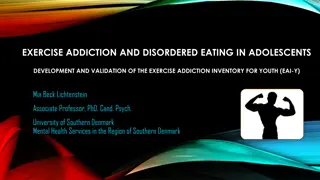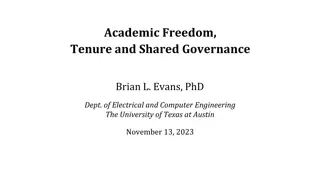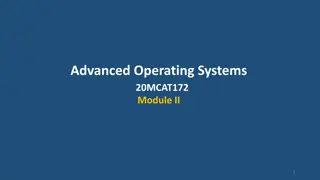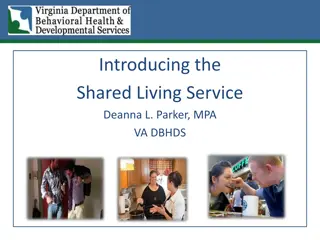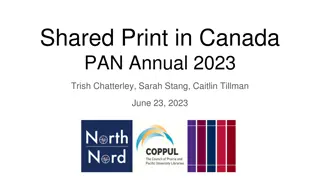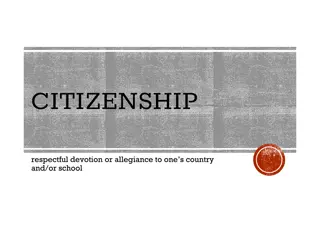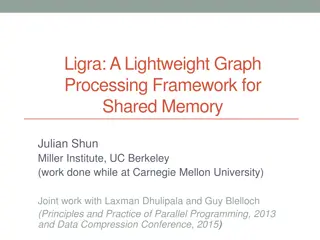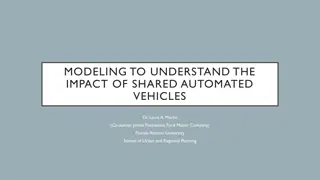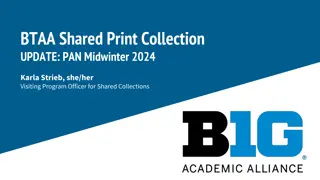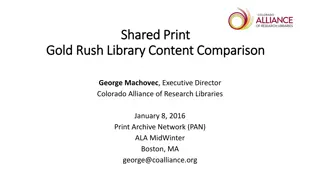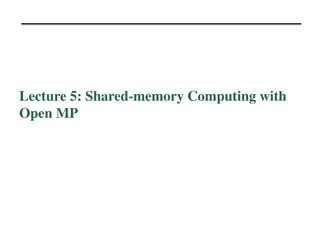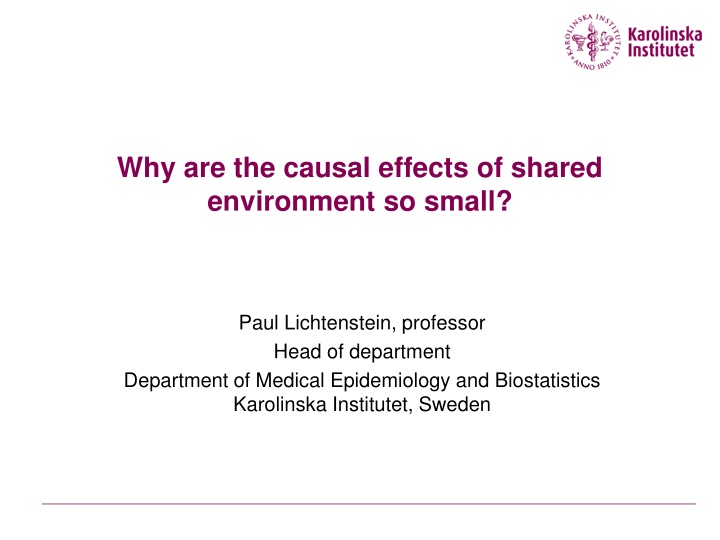
Understanding the Impact of Shared Environment on Human Traits
Explore the research led by Paul Lichtenstein, a professor at the Karolinska Institutet in Sweden, on the limited causal effects of shared environments on psychiatric phenotypes. Discover how twin and family methods reveal the minimal influence of shared environment and the implications of this finding on our understanding of genetic and environmental interactions.
Download Presentation

Please find below an Image/Link to download the presentation.
The content on the website is provided AS IS for your information and personal use only. It may not be sold, licensed, or shared on other websites without obtaining consent from the author. If you encounter any issues during the download, it is possible that the publisher has removed the file from their server.
You are allowed to download the files provided on this website for personal or commercial use, subject to the condition that they are used lawfully. All files are the property of their respective owners.
The content on the website is provided AS IS for your information and personal use only. It may not be sold, licensed, or shared on other websites without obtaining consent from the author.
E N D
Presentation Transcript
Why are the causal effects of shared environment so small? Paul Lichtenstein, professor Head of department Department of Medical Epidemiology and Biostatistics Karolinska Institutet, Sweden
Outline The question: Why do we care about shared environment The method: Twin and family methods The empirical results: Very little shared environment for psychiatric phenotypes The meaning: How should we interpret the limited effect of the shared environment? The conclusion: Life is unfair should we bother?
Familial aggregation WHY?? - Genes? - Environments? Lichtenstein et al, 2009, Lancet
Nature or Nuture? Environ- ments Genes 1920 1800 Mendel s inheritance laws rediscovered 1960 1950 Reaction to Nazism DNA discovered 1980 1970 Development of molecular genetics Left- and environmental concentration on public debate 2000 Human genome project After Plomin & Petrill, Intelligence, 1997
The twin method: Correlations Monozygotic (MZ) Dizygotic (DZ) 1 0,8 Correlation 0,6 0,4 0,2 0 Shared environment
The twin method: Correlations Monozygotic (MZ) Dizygotic (DZ) 1 0,8 Correlation 0,6 0,4 0,2 0 Shared environment Genes
The twin method: Correlations Monozygotic (MZ) Dizygotic (DZ) 1 0,8 Correlation 0,6 0,4 0,2 0 Shared environment Genes Nonshared environment
The twin method: Correlations Monozygotic (MZ) Dizygotic (DZ) 1 0,8 Correlation 0,6 0,4 0,2 0 Shared environment Genes Nonshared environment Both genes and shared environment
The Twin method: Model fitting MZ = 1.0 DZ = 0.5 1 E A C C A E e a c c a e T1 T2
Sweden best in class Swedish Twin Register The Multi-Generation Register
The Multi-Generation Registry Individuals born in Sweden > 1932 N ~ 9 million Link with biological and adoptive parents N ~ 15 million
Pedigrees from the MGR I:1 I:2 I:3 II:2 II:3 II:4 II:5 II:6 II:7 II:1 III:2 III:3 III:4 III:5 III:6 III:7 III:8 III:1 Half cousins Full cousins Half siblings Full siblings
Extended children-of-twins model (ECOT) Twin children part Twin parent part 1.0 1.0 / 0.5 1.0 1.0 A1 C1 E1 E1 C1 A1 A1 C1 E1 E1 C1 A1 a1 a1 c1 c1 e1 e1 a1 c1 e1 c1 a1 e1 Parenting on Twin1 Parenting on Twin2 Parenting Twin1 Parenting Twin2 m 0.5 0.5 m n n m 0.5 0.5 m n n Child Child Child Child Adjustment Twin1 Adjustment Twin2 a1' a1' Adjustment Child1 Adjustment Child2 a1' a1' a2 c2 e2 e2 c2 a2 A1' A1' a2 c2 e2 e2 c2 a2 A1' A1' A2 C2 E2 E2 C2 A2 A2 C2 E2 E2 C2 A2 1.0 1.0 / 0.5 0.25 / 0.125
Percentage of Variance Personality: Meta analyses of twin and adoption studies Genetic Shared environmental Nonshared environmental 100% Familial aggregation most often due to genetic factors Environmental effects most often unique for each family member Shared environment (family environment) small (but significant) effect 80% 60% 40% 20% 0% Extra- version Emo- tionality Sociability Agree- ableness Culture After Loehlin,1992
MaTCH MaTCH http://match.ctglab.nl Contains summary results from 2,748 twin studies 527 studies of the eight PGC disorders
MaTCH 8 PGC disorders N studies 153 50 89 26 N MZ pairs 94,477 18,917 86,450 37,329 N DZ pairs 94,196 6,458 121,139 68,559 Alcohol Dependence Anorexia Nervosa ADHD Autism Spectrum Disorder Bipolar Disorder Major Depressive Disorder 10 163 9,251 98,314 15,752 121,935 24 25,806 31,994 Obsessive Compulsive Disorder Schizophrenia 12 19,841 29,457
Shared environment - no or small effect Abnormal environment? What phenotype? What is shared environment really? How much could you expect? Why are people so provoked?
Abnormal environment Severe deprivation during early childhood influence development! Rutter and Romanian adoptees (summarized in JAACAP, 2012) Severe deprivation Quasi-autism Disinhibited attachment Inattention/overactivity Cognitive impairment
Romanian children adopted to British families before and after age 6 months p<.001 Rutter et al, JAACAP , 2012
What phenotype? Some phenotypes do show clear shared environmental effects Externalizing behavior Criminality Substance abuse Socioeconomic status
Percentage of Variance Convictions for violent criminality Nonshared environmental Shared environmental Genetic 100% 80% 60% 40% 20% 0% Violent criminality Frisell et al, Psychol Med , 2011
Abuse Twin, sibling and adoption studies (Kendler and Sundqvists) Kendler et al, Psychol Med , 2016
Andel av variationen Utbildningsniv i f delsekohorter Genetik Gemensam milj Unik milj 100% 90% 80% 70% 60% 50% 40% 30% 20% 10% 0% 1886- 1925* 1926- 1958* M n 1953- 1954** *Lichtenstein, Pedersen & McClearn, 1992, Acta Sociologica **Fischbein, Lange & Lichtenstein, 1997, Scandinavian Journal of Educational Research
Andel av variationen Utbildningsniv i f delsekohorter Genetik Gemensam milj Unik milj 100% 90% 80% 70% 60% 50% 40% 30% 20% 10% 0% 1886- 1925* 1926- 1958* M n 1953- 1954** Kvinnor? *Lichtenstein, Pedersen & McClearn, 1992, Acta Sociologica **Fischbein, Lange & Lichtenstein, 1997, Scandinavian Journal of Educational Research
Andel av variationen Utbildningsniv i f delsekohorter Genetik Gemensam milj Unik milj 100% 90% 80% 70% 60% 50% 40% 30% 20% 10% 0% 1886- 1925* 1926- 1958* M n 1953- 1954** 1886- 1925* 1926- 1958* 1953- 1954** Kvinnor *Lichtenstein, Pedersen & McClearn, 1992, Acta Sociologica **Fischbein, Lange & Lichtenstein, 1997, Scandinavian Journal of Educational Research
Percentage of Variance Stressful life events Genetic Shared environment Nonshared environment 100% 80% We (our genes) influence our environment The more controllable the higher heritability 60% 40% 20% 0% Plomin et al, 1990, Psychol Aging
Neighborhood deprivation is genetic Sariaslan et al, Transl Psychiatry , 2016
How about parenting? Parental criticism: Girls 16 year old Genetic Shared environmental Nonshared environmental 100% The child s genes influence parenting Evocative gene-environment correlation 80% 60% 40% 20% 0% Parental critisism Narusyte et al, 2007, Europ Child & Adol Psychiatry
Shared environment - no or small effect Abnormal environment? What phenotype? What is shared environment really? How much could you expect? Why are people so provoked?
Shared environment - no or small effect Abnormal environment? What phenotype? What is shared environment really? How much could you expect? Why are people so provoked?
Conclusion Shared environment have limited effects especially for severe psychopathology Does not mean that parenting and treatment are meaningless No causal effects of shared environment but causal effects of parenting Life is unfair would it be better if it was because of the shared environment?

